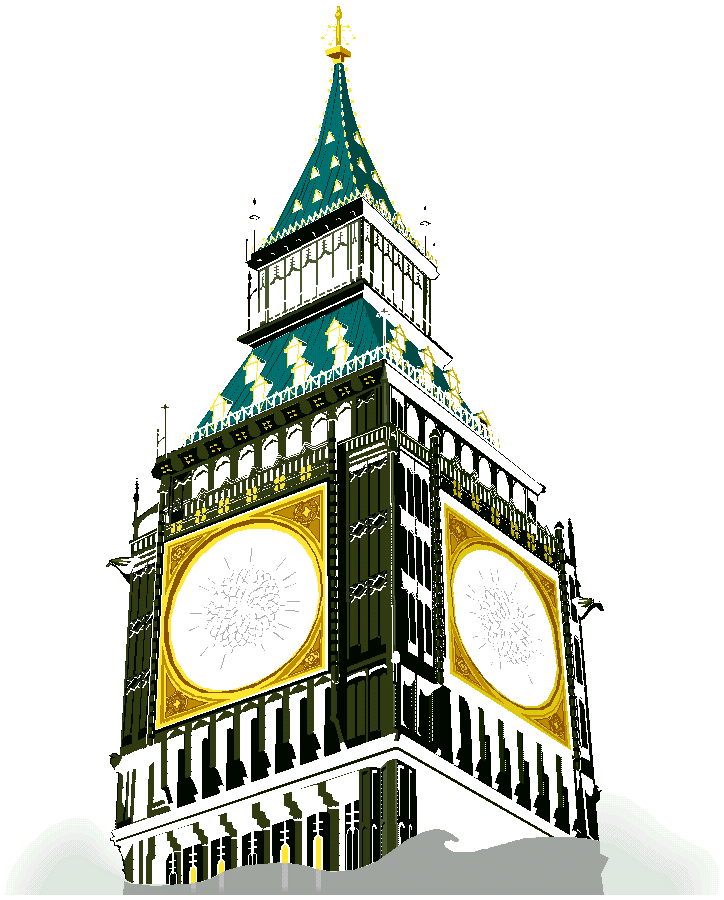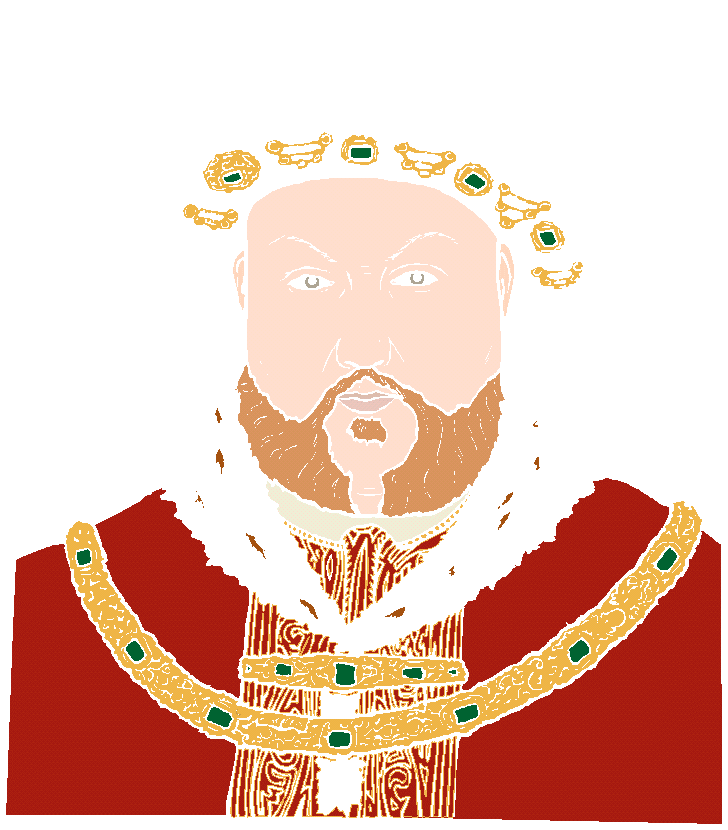

The first advanced culture in Britain was that of the Celts who arrived from the European continent around 500 BC. The Celts survived early raids by Caesar in 55 and 54 BC, but fell to a follow-on Roman invasion in 43 AD. The Romans named their new province Britannia (after the Celtic Brython tribe), built cities and roads, instituted Roman law and administration, and later introduced Christianity.
When the Roman Empire collapsed in the 5th century, the way was opened to invasions by the Germanic Angles, Saxons, and Jutes. These new conquerors divided the land into several tribal kingdoms, introduced an Anglo-Saxon language, new laws, and a pagan religion. Soon the island was known as Angle Land, eventually shortened to simply England.
In 597 AD, Pope Gregory I sent the monk Augustine to convert the English pagans to Christianity. Augustine did convert king Ethelbert of Kent and established a monastery at Canterbury. The Pope made Augustine archbishop, and since that time the Archbishop of Canterbury has been head of the church in England.
In the 9th century, Danes threatened the island. The Danish conquest was checked by Alfred the Great who managed to unite the Anglo - Saxon tribes and defeat the Danish army (878). Many historians thus recognize Alfred as the first English king. Alfred's victory only forestalled the Danish threat, however, and a century later the Danes renewed their attacks. In 1016, Canute, King of Norway and Denmark, declared himself King of England as well. By 1042, the English had regained the throne in the person of Edward the Confessor.
Edward died in 1066 without an heir. The English chose Harold of Wessex to be their new king, but Edward's cousin William of Normandy had other ideas. William invaded and met Harold in the Battle of Hastings on 14 October 1066. Harold was killed by an arrow through the eye, and William the Conqueror was crowned King of England in Westminster Abbey on Christmas day.
Westminster Abbey was established by Edward the Confessor, last Saxon king. The original chapel was rebuilt by Henry III who had Edward laid to rest behind the High Altar. Since that time, the Abbey has been the burial site of many kings and queens of England as well as principal figures throughout British history including statesmen, artists, poets, musicians, heros and, most recently, was the site of funeral ceremonies for Princess Diana. For example, in Poet's corner are the burial sites of Chaucer, Kipling, and Dickens. All monarchs except Edward V and Edward VIII were crowned in the Abbey. The coronation chair, by the way, was built to hold the "Stone of Scone." This stone was used in the crowning of Scottish kings but was captured by Edward I in 1296 and prominently displayed in the coronation chair where it still resides.
William the Conqueror deposed the existing aristocracy, installed his own Norman lords, introduced French as the language of the court (though it quickly blended with Anglo - Saxon), undertook a rebuilding program (Norman - style cathedrals and public buildings including the Tower of London), and placed new emphasis on the monasteries as advanced centers of learning.
The Tower of London has served as a fortress, palace, and prison. Among its more prominent prisoners were Mary Queen of Scots, Anne Boleyn, Sir Walter Raleigh, Sir Thomas More, Lady Jane Grey, and the young Princess Elizabeth, later Elizabeth I. Today, it houses the crown jewels which include the 530 carat Star of Africa diamond which is set in the royal sceptre.
The order established by William the Conqueror disintegrated under William II and the weak Stephen. Desiring a strong leader again, the English chose Henry II as their new king. Henry II was the first of the Plantagenet family, a family that ruled for 245 years. He is best remembered for his development of common law and the grand jury system, and his quarrel with Thomas Becket, Archbishop of Canterbury, about jurisdiction over clergymen who commit crimes. Becket's insistence on the right of the church to try such men was an attack on the authority of the king. Whether or not they acted on Henry's orders we may never know, but four knights murdered Becket in Canterbury cathedral on 29 December 1170.
Henry II was succeeded by his son Richard the Lion Hearted. Richard ruled for about ten years, but he only spent six months of that time in England. Otherwise, he was off fighting the Crusades. Richard was succeeded by his brother John, the most despised of all English monarchs (and perhaps the only true character in the Robin Hood legend). He was such a tyrant that the barons forced him to sign the Magna Carta which established, among other principles, that the king is not above the law and must rule in accordance with the law (at Runnymede on 15 June 1215).
A visit to the British Museum is an absolute must where, amongst so many other historically significant items, you can see the Magna Carta, the Elgin marbles, Egyptian mummies, tour the reading room where Karl Marx wrote Das Kapital, and view the Rosetta Stone which unlocked so many mysteries of ancient civilizations.
The 13th century saw a number of progressive movements in England including the adaptation of Gothic architecture, a new emphasis on learning and the rise of Oxford University, new trade routes established by the Crusades, and increases in the power of Parliament. The 14th century brought the Hundred Years War with France and the Black Death (bubonic plague). During the "Hundred Years War" (1337 - 1453) there were a number of early English victories. Notable victories include Crecy where the English longbow was introduced (1346), the Battle of Poitiers (1356) where the Black Prince (son of Edward III) gained fame, and the Battle of Agincourt (1415) where about 5000 Englishmen armed with longbows defeated a French force of about 25,000 men. The tide was turned at Orleans, however, where French forces, led by Joan of Arc, broke through the English siege (1429). By 1453, despite burning Joan, the English had lost all their French possessions except Calais. Even more than the war, however, the plague (1348 - 1349) devastated England. About one in every four died including half the citizens of London. Whole towns disappeared, and the resulting lack of "manpower" essentially doomed the long standing feudal system.
 After the Hundred Years War, a struggle for the crown
ensued between the Houses of Lancaster and York. The "War of the
Roses" (each family crest included a rose) lasted 30 years. When
the last Yorkish king was killed in the Battle of Bosworth Field (1485).
Henry VII, first of the Tudors, ascended the throne. He was succeeded by
his son, Henry VIII (1509). Henry VIII had six wives; Catherine of
Aragon (mother of Mary I) whom he divorced, Anne Boleyn (mother of Elizabeth
I) whom he beheaded, Jane Seymour (mother of Edward VI) who died in childbirth,
Anne of Cleves whom he divorced, Catherine Howard whom he beheaded, and
Catherine Parr whom he widowed. Henry VIII once wrote a treatise denouncing
Martin Luther for which the Pope gave him the title "Defender of the
Faith," a title English monarchs carry to this day. Ironically, Henry
VIII also broke off relationships with the Pope over the divorce of Catherine
of Aragon, and established an independent Church of England.
After the Hundred Years War, a struggle for the crown
ensued between the Houses of Lancaster and York. The "War of the
Roses" (each family crest included a rose) lasted 30 years. When
the last Yorkish king was killed in the Battle of Bosworth Field (1485).
Henry VII, first of the Tudors, ascended the throne. He was succeeded by
his son, Henry VIII (1509). Henry VIII had six wives; Catherine of
Aragon (mother of Mary I) whom he divorced, Anne Boleyn (mother of Elizabeth
I) whom he beheaded, Jane Seymour (mother of Edward VI) who died in childbirth,
Anne of Cleves whom he divorced, Catherine Howard whom he beheaded, and
Catherine Parr whom he widowed. Henry VIII once wrote a treatise denouncing
Martin Luther for which the Pope gave him the title "Defender of the
Faith," a title English monarchs carry to this day. Ironically, Henry
VIII also broke off relationships with the Pope over the divorce of Catherine
of Aragon, and established an independent Church of England.
The last Tudor, Elizabeth I, oversaw the Renaissance in England and made England a great power among nations through development of the navy, exploration, trade, and outright plundering, particularly Spanish vessels. Elizabeth's general persecution of Catholics, her treatment of Mary Queen of Scots, and her raids on Spanish ports and ships prompted Spain to launch the great Spanish Armada. England's defeat of the Armada made her the undisputed master of the seas. Elizabeth I died without an heir.
The crown was passed to the Scottish Stuarts who insisted they ruled by "divine right" and answered only to God, not Parliament. The first Stuart, James I, (whom we Americans associate with Jamestown and the King James version of the bible), alienated almost everyone. He's the one who prompted the Gunpowder Plot (1605), a foiled attempt to blow up Parliament by Guy Fawkes (an event the English "celebrate" still today). Charles I was no better, perhaps worse, and civil war ensued. The war pitted Puritans against Catholics and the aristocracy. The Puritans won and beheaded Charles I. The new Commonwealth, however, led by the despotic, puritanical Oliver Cromwell, and his son Richard ("Tumbledown Dick"), soon collapsed and the Stuarts were asked to return to the throne in the person of Charles II. When the last Stuart, James II, was blessed with a male heir, however, and the people saw that the Stuart rule would continue, they decided they had had enough and wanted no more Catholics on the throne.
Parliament asked Mary (Protestant daughter of James II) and her Dutch husband, William of Orange, to accept the crown. They did and James II fled the country ending the so-called Glorious Revolution of 1688. In 1702, the crown passed to a second Protestant daughter of James II, Anne. During Queen Anne's reign, the Act of Union was passed (1707) uniting England and Scotland under one crown with one Parliament. Thereafter, the kingdom was referred to as Great Britain.
Anne outlived all of her 17 children. Her nearest relative was George I of Hanover who spoke no English and had no interest in British affairs. Although he ruled as king, he left governing to Sir Robert Walpole who became the first Prime Minister. George III tried to be king, but mismanaged most affairs and lost the American colonies. The British were more successful in dealing with Napoleon. While Napoleon enjoyed success on land, he was checked at sea by Horatio Nelson who decisively defeated the French fleet at Trafalgar in 1805 though Nelson himself was fatally wounded. Since France had no hope of invading, the British had time to build an army. Under the leadership of the Duke of Wellington, the British army and its allies destroyed Napoleon's forces at the Battle of Waterloo in Belgium (1815).
Twelve years after Waterloo, Queen Victoria assumed the throne and reigned for the next 64 years. Her rule saw Great Britain enter the 20th century as one of the most powerful nations on earth.
